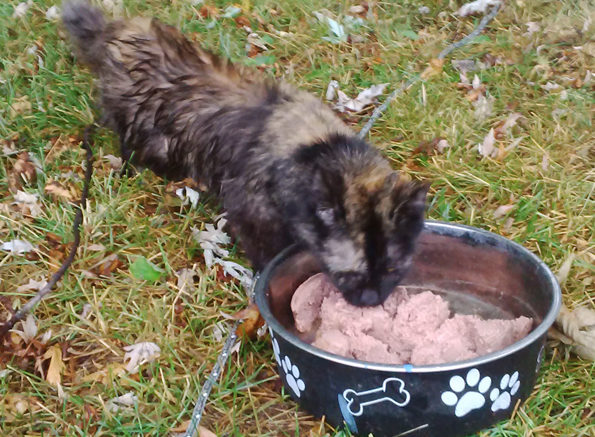Adam Bramburger
Beaver Staff
Lodge Coffee Shop co-owner Cassandra Rendell has noticed one regular topic of conversation cropping up among customers recently.
“It’s common conversation to talk about the cats of Bath,” she said.
Rendell says there are about stray cats that come to her property regularly and about three others that drop in often for food or water.
She said business owners in the village have become concerned with the population of stray cats in Bath, some they suspect are overflows from a Main Street house the Ontario Society for the Prevention of Cruelty to Animals (OSPCA) investigated regarding a hoarding situation. More than a dozen cats were thought to have been removed.
Another business owner contacted Heather Patterson, the founder of For the Love of Ferals, a Camden East area rescue organization, to offer help.
“We knew there was an overpopulation of stray cats in Bath. As business owners, we didn’t know what to do or where to turn,” Rendell said. “With Heather’s help, it feels like we’re making a plan to do something to help the cats, we just need the funds to follow through on those plans.”
A cat lover herself, Rendell said simply feeding the colony will not stop the problem. Proper rehoming is the only viable solution.
That’s a big part of the work Patterson does at For the Love of Ferals, mainly in rural areas. After volunteering with Spay and Neuter Kingston, started her own rescue about two years ago. She’s worked to care for two colonies in the Erinsville area and has had calls from around lower Lennox and Addington for help.
“We go wherever is needed, depending on our funds and our availabilities.”
While many rescues focus on removing kittens, Patterson believes working with adult cats is the most effective means for managing feral populations.
“We focus on trap-neuter-vaccinate-and-return,” she said. “You can take the kittens away, but if you don’t fix adults, you don’t accomplish anything.”
After trapping adult cats and taking them to a partnering veterinarian, Patterson says For The Love of Ferals will either seek to return the cats where they come from, if there’s a colony caretaker ready to feed and monitor them, or it will try to reintegrate them in a barn.
“We go to a barn and do a visit prior to agreeing to place any cats there,” she said. “There needs to be shelter, preferably heated, a caretaker that has to feed and water them every day, and there can’t be current barn cats there,” she said.
Support is provided to allow the cats to become accustomed to their new homes. The rescue also has a food program to help people trying to take care of colonies.
The trouble, however, is time and money. Patterson has just two people working at her rescue and both have full-time jobs. They also need funding to support their trapping and feeding efforts, as well as veterinary costs.
“Our plate is full right now, we’re maxed,” she said. “I have barns waiting for me to go and visit them to place a good majority of these cats, but we’re not getting anywhere with the people of Bath to do fundraising, outside of the coffee shop.”
Patterson said, on the whole, private rescues can’t keep up with the demand, particularly as there is only so much space available at the OSPCA, which doesn’t take outdoor cats.
It’s also not uncommon for people to drop cats off to avoid surrender fees.
“ I don’t think a lot of people realize how bad the problem is,” Patterson said. “You don’t see them typically. When people drive up, they run. They’re everywhere… This isn’t just a Bath problem. It’s Amherstview, it’s Napanee.
While Patterson is hopeful that people will step forward with funds to help control Bath’s feral cat problem, she said she’s also hoping to raise awareness by bringing the cats to the public’s attention. She recalled a story of a cat she found in Amherstview recently that died of starvation. If someone had fed the cat, it might have helped it to live.
“She ended up at someone’s house who didn’t want to feed her because they didn’t want her there. The time at the house could have made all the difference to her. People lack compassion because there are so many of them. They think they are rodents. They think they’re a nuisance,” she said.
Patterson added that even those who are trying to help often don’t know who to call, especially with private rescues stretched thin. She gets calls and e-mails on a daily basis and has had to turn to rescues in Toronto. Shelburne, and Erin to help with the overflow.
Patterson said she feels the best solution would be high-volume, low-cost spay and neuter services.
An animal control bylaw that deals with cats may be a positive development and any programs that assist people with spaying and neutering will also help. As it stands, most municipalities only have bylaws addressing dogs.
“If it was a pack of wild dogs in Bath, the entire community would be in an uproar. If it’s a colony of feral cats, nobody seems to care.”
Rendell is optimistic that business owners may lead the charge, however, to make improvements in Bath-area colonies. The Lodge was holding a pay-what-you-can yoga class yesterday with all proceeds going to the effort. It also planned to put out a collection jar and encourage other business people in the village to do likewise.

